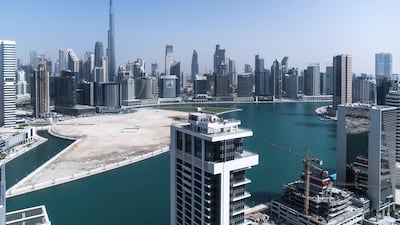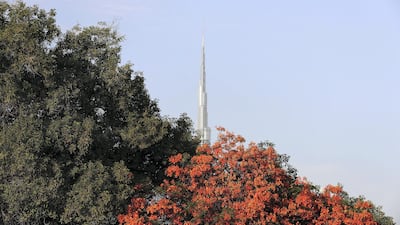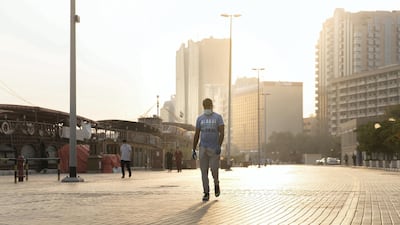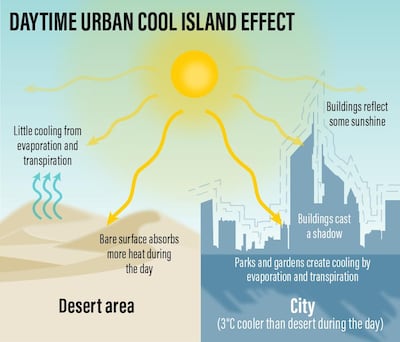A study has shown how Dubai's skyscrapers create an "urban canyon" cooling effect which can reduce temperatures significantly.
It is enhanced by the fact the city is surrounded by barren desert which heats up much more quickly.
This "urban cool island" effect - in which built-up areas have lower temperatures than surrounding rural districts - is much stronger in Dubai than in other major cities.
Experts believe this effect can make the city as much as 3°C cooler than adjacent desert and results from the study could help in the design of green corridors.
These channels could provide some respite from scorching daytime heat.
“The reason these [urban cool islands] emerge and they’re so dominant is if you go outside the city limits, outside the developed areas of Abu Dhabi and Dubai, you’re in barren desert with very little vegetation,” said Jake Dialesandro, a researcher on the project.
“The areas of desert heat up unbelievably quickly because they’ve a lot of soil and an absence of moisture … They also cool down quicker.”
Urban cool islands are less common than urban heat islands. But after dark, however, the urban heat island takes precedence in Dubai. And the city can be about 2°C warmer than the surrounding desert at night, with the warm waters of the Arabian Gulf said to be partly the reason for this.
Temperatures were measured during day and night in several places in and around 10 urban areas. Just three cities – Dubai, Madrid and Tehran – showed the urban cool island effect, and Dubai’s was the strongest.
Areas with heavy vegetation, such as parks, were typically slightly cooler than adjacent districts, partly because these areas releases water from evaporation and transpiration, processes that use heat and cool the immediate environment.
Initial findings were published in the Environmental Research Communications journal last year and the research project continues, with more results to be released soon.
Another of the paper’s authors, Dr Yaser Abunnasr, from the American University of Beirut, who carried out the UAE fieldwork, said Dubai’s taller buildings created shade that kept temperatures down.
“Many of the skyscrapers in Dubai, they’re mostly made of glass,” he said. “It casts a shadow and reflects a lot of the sun’s energy, [although] sometimes, because of the reflection you’re heating the area around as well.”
The daytime temperature in a shaded “urban canyon” may be 35 °C when surrounding areas have a temperature of 43 °C, said Mr Dialesandro, a postgraduate researcher at the University of California.
“What we’ve found in our research is size and shape of the green space has an impact. If you have a long, linear green space, that will have less of an effect than if you have a large cohesive green space,” said Mr Dialesandro. The cooling effect of such large green spaces extends into adjacent areas that have buildings and roads.
To save water, more native plants could be planted, as they require less water than vegetation from temperate regions.
“One of the things is to use very low water demand trees … [and to] develop a whole network of parks and gardens connected by tree-lined streets,” said Dr Abunnasr.
While native flora is preferred, areas with sparse xeric vegetation – succulent plants like cacti that need little water – warmed more quickly during the daytime, so plants must be chosen carefully.
In a separate study published in June in the journal Climate, researchers in Dubai and Australia found that sea breezes contributed to Dubai's urban cool island effect.
"Several factors could be the cause of negative urban heat island values," the researchers wrote. "In this case, two of the main reasons could be the hot air that, coming from the desert, increases the air temperature in the rural area more than in the urban area and the presence of the sea breeze mitigates the urban overheating when the cold wind blows from the seaside."
The daytime urban cool island effect is typically not seen in temperate regions, where heavily vegetated countryside warms more slowly than urban areas.









